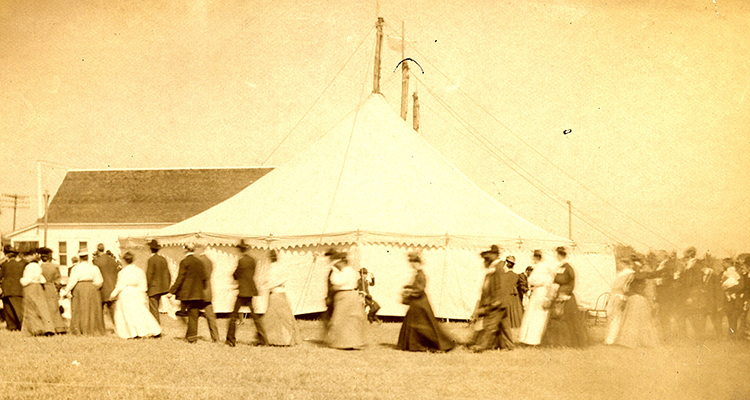
The Nazarene founders could have chosen October 16, 1907, as the denomination’s official anniversary date. That was when a new denomination was created by the First General Assembly meeting in Chicago, Illinois. One year later, the Second General Assembly, meeting in Pilot Point, Texas, from October 8-14, 1908, expanded the new denomination’s numbers and made it truly national by reaching deep into the (U.S.) South.
At the Sixth General Assembly in 1923, the founders chose an official anniversary date for the church, but instead of applying the “logic of firsts,” they used “the logic of inclusion,” choosing the Second General Assembly as the benchmark for observing “this great spiritual marriage.” There is good reason to be glad that they did.
The primary agenda at both General Assemblies was to effect mergers. The assemblies were linked so closely that the sixth general superintendent, John Goodwin, later observed that the Second General Assembly functioned as an “adjourned” (or carryover) session of the First. The assemblies united regional churches from America’s east and west (1907) and south (1908). There were later mergers, including two major accessions in 1915, but the three churches that united across two Octobers gave the united church its essential shape and character.
The East-West union merged regional churches that had compatible cultures. The North-South union was different, with regional differences between merger partners that were sharper and more complex, with the divisive politics of 19th century America looming large in the background.
From the 1820s on, the slavery issue had alienated Americans along regional lines. In the 1840s, the growing animosity between North and South divided the major Protestant churches — Presbyterians, Baptists, and Methodists. In Broken Churches, Broken Nation, historian C. C. Goen argued that these schisms actually accelerated the movement towards war, since each division of a national church loosened one more national bond that had once bound the American people to one another. Then came the bloody and devastating Civil War of the 1860s. Slavery, regionalism, and war had poisoned the well of American Christianity. The situation merited H. Richard Niebuhr’s condemnation that the broken denominations stood out on a bleak cultural landscape as naked emblems of “the world’s triumph over the Church.”
Consider how unlikely the Pilot Point merger really was. Those who met in October 1908 at Pilot Point, Texas, understood this history of regional conflict and war. The older ones present had lived through it. The younger ones had been schooled in it. The Methodists did not reunite their northern and southern denominations until 1939. The Presbyterians did not do so until 1983. The Baptists have never done so. But in 1908, in a small Texas town, the holiness people looked beyond the social and political estrangement, the legacy of suspicion and regional stereotyping, and they united their forces in the name of Christian holiness.
Historian Abel Stephens wrote that American Methodism succeeded in its first century because its preachers proclaimed that God’s divine grace is imparted to sinners and actually changes them. Early Nazarenes inherited this message of transforming grace. The union of churches at Pilot Point was a shining example of the social reality of Christian holiness. At the heart of the Christian message is a word of reconciliation: first between sinners and Divine Love, and second, among estranged members of the human family. Pilot Point signifies the reality that holiness heals hearts and unites people who are otherwise driven apart by sin and conflict.
The minutes of the Second General Assembly state that on Tuesday morning, October 13, Phineas Bresee called the assembly to order at 8:30 a.m. Various leaders from the different sections made speeches celebrating the approaching merger.
Then “Bro. R. B. Mitchum spoke in a very tender way of the gracious leadings of God up to this moment. He desired to move that ‘the union of the two Churches be now consummated.'” Others seconded the motion. Bresee announced that this was “an epoch-making time” and “an answer to Christ’s prayer” for Christian unity.
The minutes state that “the motion being put, it was passed unanimously by a rising vote, amid great enthusiasm” at 10:40 a.m.
“The burst of holy joy continued for several minutes, brethren of the South throwing their arms around brethren of the North, East, and West, at the same time singing a new hymn for the occasion. . . . Soon the inside of the tent became too small for the freedom of such joy, and the people began marching out and around the great tent, with waving handkerchiefs and shouts of joy, and eventually formed in an immense solid circle on the grounds, where Dr. Bresee mounted a chair and addressed the multitude in words of inspiration.”
Pilot Point left an indelible impression on those present. For them, it was an experience of reconciling love and a symbol the gospel can triumph over the divisive and chaotic forces of this world.
Today it remains a potent and enduring symbol that genuine Christian holiness creates new social realities. Pilot Point retains the power to speak to us as a church whose people now represent so many different nationalities, races, cultures, and tongues.